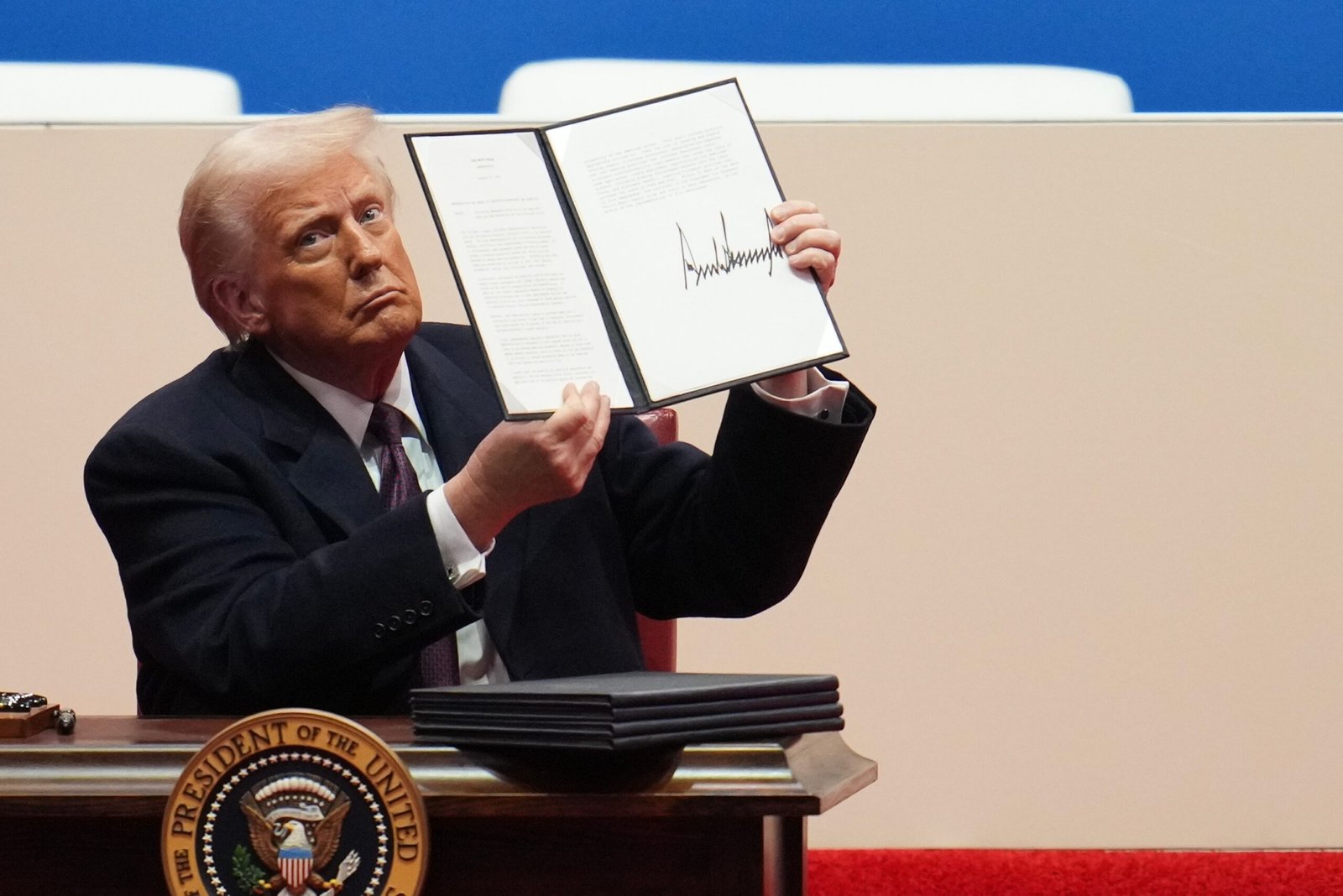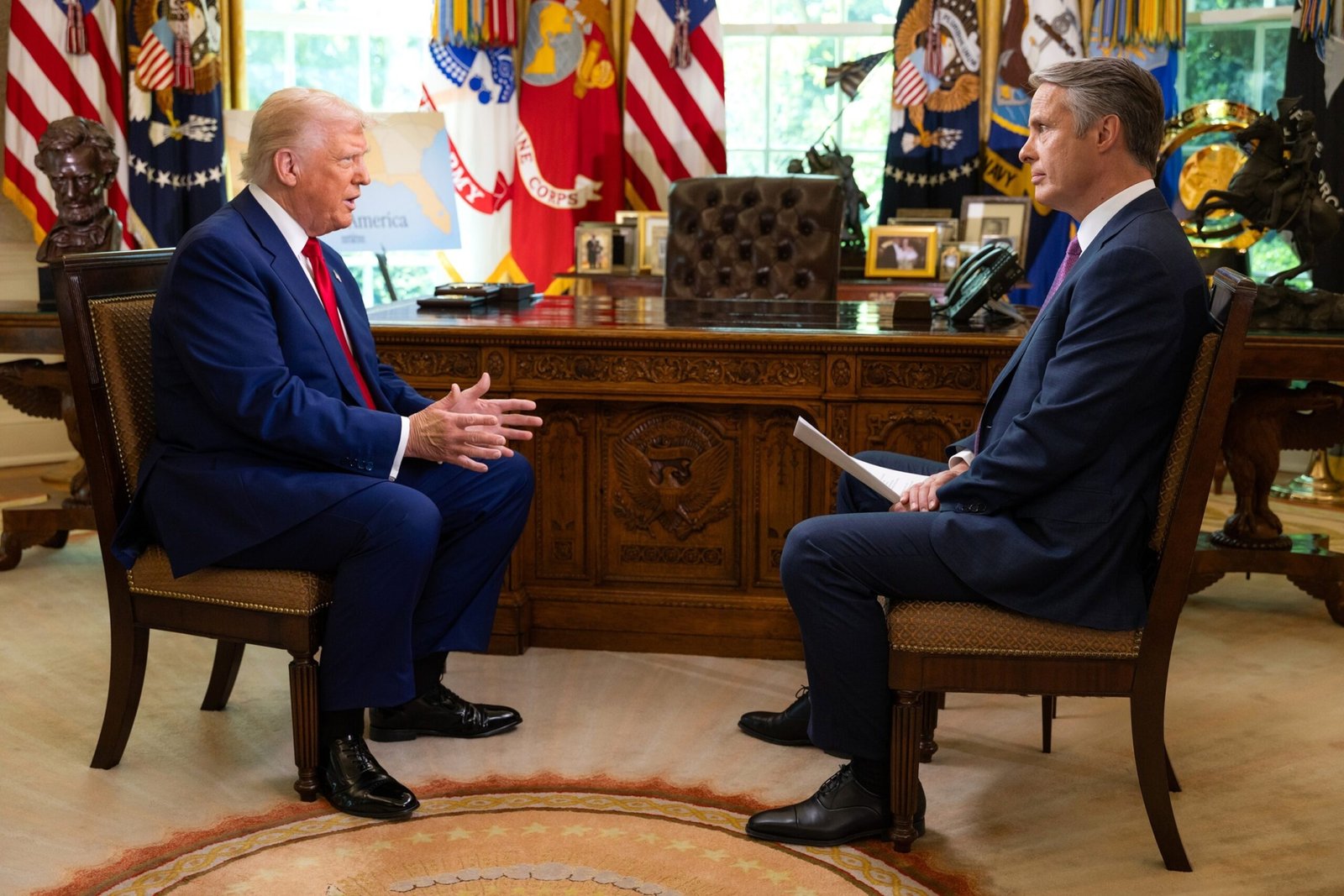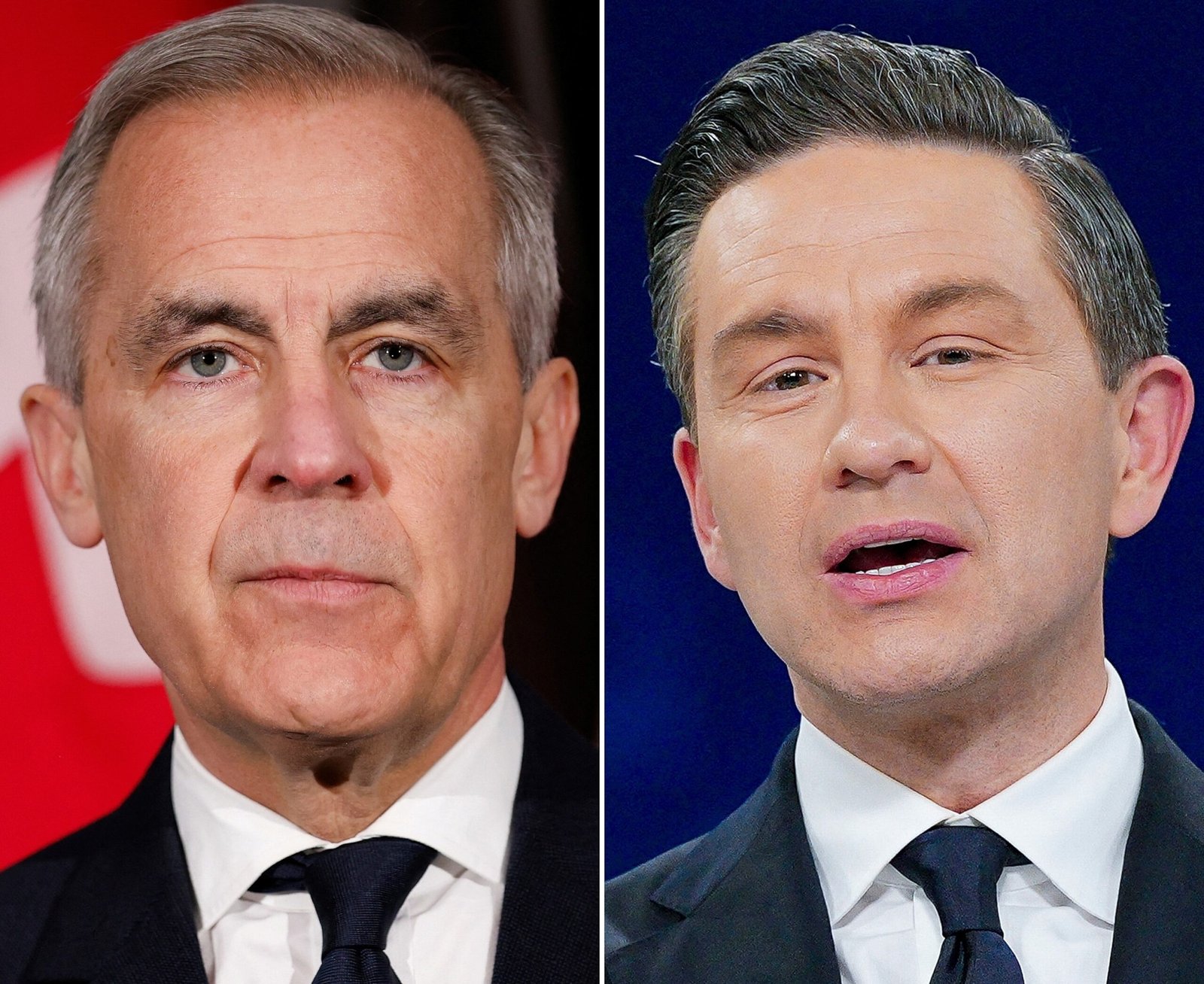On the path of the campaign, and in the weeks prior to his return to the White House, President Donald Trump promised to start operating, what experts describe as a “flooding of the area” strategy to advance their conservative and controversial policies.
The rhythm has meant the first 100 days often unprecedented in the position: “Trump speed”, the White House calls it.
Earlier this month, he told Republican legislators at a party dinner: “We are establishing records at this time. We are obtaining more approved things than any president he has done in the first 100 days. He is not even close. I made someone say the most successful month, first month in history. They now said the 100 most successful days in the history of our country.”
How he has done it, legal experts told ABC News, they will have a lasting impact on the federal presidency and government.

President Donald Trump stops an executive order after signing it during an interior opening parade in Capital One Arena, on January 20, 2025, in Washington, DC
Christopher Furlong/Getty images
Its main strategy has been to sign executive orders almost daily, including those that challenge the power of Congress to finance and supervise federal agencies and programs, while others relentlessly prove the limits of immigration application.
Other presidents on both sides of the hall have tried to flex their executive muscle, such as the EO of President Joe Biden to demand that 50% of cars and light trucks sold are electric vehicles of zero emissions by 2030, according to Tabitha Bonilla, an assistant research professor at the Northwestern University Policy Research Institute.
“Each president in recent decades has been trying to add more power to the executive branch and send their agenda,” Bonilla told ABC News. “Trump is taking that to the extreme.”
As an example, experts quoted Trump using legal and financial threats to punish universities and law firms for alleged political opposition and the failure to “align” with their agenda, as well as with their decisive to wholesale of the high career officials, replacing them with loyal.
James Sample, an expert in constitutional law of the University of Hofstra, said that Trump’s play book seems to be directly out of the 2025 project, a plan to “take the reins of the federal government” prepared for years by the most conservative allies of Trump in advance of his return, although Trump said he never read it.
Trump and his supporters said that their actions are justified because the bureaucrats and judges not elected, they claim, had seized the control of the presidents, the only person chosen throughout the country, argue, and granted the total executive power by the Constitution.
Anyway, the sample said, the tactics must lift a red flag.
“The purpose of a blitzkrieg is to overwhelm the opposition,” he said.
While Trump’s tactics have met with little or no protest of Republican legislators who control the Chamber and Senate, the judicial branch has often been ready to stop the flood through decisions and mandates in dozens of judicial cases.
Even so, experts told ABC News, that even if all Trump movements are blocked or even reversed, they have caused serious and long term serious damage.
“It’s about implanting the narrative,” Bonilla said. “Trump’s policies and rhetoric have pushed everything to the right and have harmed our strength worldwide.”
The gates opened
Since Trump assumed the position on January 20, he issued more than 140 executive orders on various policies until Monday, breaking records and an improvement of widely sustained interpretations of the Federal Law and the Constitution.
President Joe Biden, in comparison, issued 162 EOS throughout his mandate, and Trump issued more than 30 executive orders during the first 100 days of his first mandate, according to historical records.
The White House Cabinet Chief, Susie Wiles, told Fox News in March that in this second mandate, Trump’s team knew that she needed to act quickly, citing the middle of the period elections in November 2026 that she could change the map of Congress.
“This 18 months is our period of time. One hundred days, certainly six months after the year, and 18 months, they are our reference points,” he said.

The Personnel Deputy Director of the White House of the White House, Stephen Miller, accompanied by the White House Secretary, Will Scharf, counselor of President Donald Trump Peter Navarro and President Donald Trump, speak after Trump signs a series of executive orders, on February 10, 2025, in the Oval Office.
Andrew Harnik/Getty Images
The objective of the “flooding of the area” has been touched a long time ago by Trump’s allies.
His former White House political advisor, Steve Bannon, seemed to coin the idea during Trump’s first mandate. After Trump left office, conservative activists and Trump’s loyal ones created a proposed battle plan for a second mandate.
In a 2023 speech, Russell Vought, an architect head of the 2025 project and now the current Trump director of the Office of Administration and Budget, presented a strategy in his center to renew America, a group of experts in favor of Washington.
“I want bureaucrats to be affected traumatically because they are increasingly seen as villains. We want to put them in trauma,” he said in a speech informed by Propublic.
The video of his speech was presented during Vought’s confirmation audiences earlier this year, but repeatedly avoided answering questions about his rhetoric and provocative plans.
Many of Trump’s EOS have dealt with the creation of Elon Musk: the Government Efficiency Department, which has reduced the budgets of agencies and tens of thousands of federal employees throughout the country, while others have promoted the repression of the president on immigration, as the end of the right of birth and sport of migrants such as the alleged foreign invaders under the law of 1798 alien enemies.
Bernadette Meyler, Carl’s law professor and Sheila Spaeth at Stanford’s Law Faculty, told ABC News that executive orders have always been a tool that presidents have used to establish their agenda, although only symbolically.
“It is an effective tactic. It is difficult even for the courts to react quickly,” Meyler said.
Conservative groups have long advocated a shake of the federal government and subject to the president needed more power so that the country is more efficient.
“What you are doing is to start what will ultimately will be our legislative agenda,” said the president of the House of Representatives, Mike Johnson, in January after the first round of Trump’s executive orders.
The Heritage Foundation, the group of experts on the right that helped produce the 2025 project, has argued that Trump’s efforts are essential and rapid action can make the government more efficient.
Lindsey Burke, director of the Policy of the Center for Education of the Heritage Foundation, and Jonathan Butcher, a senior researcher in the group of experts, referred to this idea in a statement last month after Trump issued an executive order for a drastic reduction in the force for the Department of Education.
“Reducing swollen bureaucracy will give state and local education officials plus decision -making authority,” they said.
Word of words, resistance to courts
Legal experts said that another effective aspect of the “flooding of the area” tactics was the multiple appearances in Trump’s media and photographs, where it continues making controversial and provocative statements.

President Donald Trump and the members of his Cabinet (LR) National Security Advisor Michael Waltz, vice president JD Vance, the secretary of the Treasury, Scott Besent, and Defense Secretary Pete Hegseth in the White House Cabinet Room, on April 17, 2025.
Win McNamee/Getty Images
Meyler argues that Trump’s War of Words is part of a deeper tactic to undermine the public’s confidence in the federal government.
He even pointed to the courts that issued mandates, Trump’s statements and resistance to the judge’s orders with aggressive appeals have still moved the needle to the right.
“It may seem that he is doing a lot even without much judicial action,” Meyler said.
How much steam is left?
Trump and his allies have remained firm that they will remain in their plans to reaffirm the powers of the executive branch long after they have finished the first 100 days and promise to take all their cases to the Supreme Court if necessary.
Until Sunday, there have been 217 judicial cases against the second Trump administration, according to an ABC news accounting, and a large majority of them have led to temporary restriction orders, reversions and, in some cases, complete blocks of the Trump agenda.
“In Trump’s first administration, we saw many executive actions at the beginning and then we saw him decrease,” said Bonilla. “We will live in the space of many things at once for a while, but at some point, there will be a time when there is so much that [the executive branch] I can’t keep up. “
Meyler agreed, but added that Trump, the 2025 Architects project and his allies have declared that they are willing to work with Congress so that their agenda passes through legislative channels.
“That could ensure their policies, and slow down things, and avoid courts,” he said.

The protesters hold signs during a demonstration entitled “Day of Action” of protest against the policies and executive actions of President Donald Trump, in Chicago, on April 19, 2025.
Kamil Krzaczynski/AFP through Getty Images
That pivot will find more resistance, especially as we approach partial exams, according to Meyler.
“It is easier for some than others due to several practical issues, but there is a turning point,” he said. “People are already protesting and Trump’s public qualifications are immersing themselves.”

The demonstrators recover during the “hands off” nationwide! “Protest against the policies and executive actions of resident Donald Trump, near the White House, April 19, 2025.
Richard Pierrin/AFP through Getty Images
Even so, future presidents will probably emulate the “flooding of the area” tactics in their first weeks, according to Meyler.
“During the long course of presidential history, there is rarely a retraction of presidential power,” he said.






